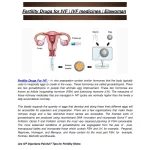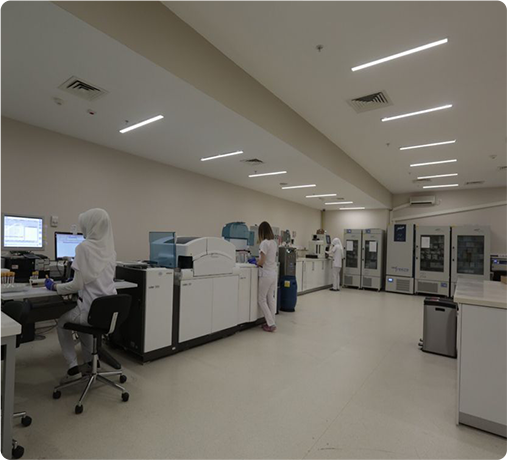
Can a Woman Self-Administer Fertility Drugs for IVF?
April 7, 2025
Can You Do Research on IVF Embryos? Exploring the Science, Ethics, and Future
April 7, 2025What Is IVF? Your Complete Guide to In Vitro Fertilization

What Is IVF? Your Complete Guide to In Vitro Fertilization
In vitro fertilization, or IVF, is a term you might have heard thrown around on TV shows, in magazines, or maybe even from a friend trying to grow their family. It’s one of those things that sounds complicated—and honestly, it kind of is—but it’s also a game-changer for millions of people hoping to have a baby. So, what exactly is IVF? At its core, it’s a process where doctors help sperm and eggs meet outside the body, in a lab, to create embryos that can then be placed into a uterus to (hopefully) become a pregnancy. It’s like giving nature a little nudge when things aren’t working on their own.
If you’re curious about how it all works, why people choose it, or what it’s really like to go through, you’re in the right place. This guide is here to break it all down—step by step, with real facts, some surprising insights, and a few things you probably won’t find anywhere else. Whether you’re thinking about IVF for yourself, supporting someone else, or just want to know more, stick around. We’ve got a lot to cover, from the science behind it to the emotional rollercoaster it can be.
How Does IVF Actually Work?
IVF isn’t magic, but it can feel that way when you see how much science goes into it. The process happens in a series of steps, each one carefully planned to boost the chances of success. Here’s what it looks like, explained in a way that makes sense even if you’re not a doctor:
Step 1: Boosting Egg Production
Normally, your ovaries release one egg a month. With IVF, doctors want more than that—think of it like casting a wider net to catch more fish. You’ll take fertility drugs (usually shots you give yourself) for about 10-14 days. These meds tell your ovaries to make several eggs at once. During this time, your doctor keeps a close eye on things with ultrasounds and blood tests to make sure everything’s on track.
Step 2: Collecting the Eggs
Once the eggs are ready, it’s time to get them out. This part, called egg retrieval, happens in a clinic. You’ll be under light sedation—nothing too heavy—so you won’t feel much. A doctor uses a thin needle guided by ultrasound to gently pull the eggs from your ovaries. It takes about 20-30 minutes, and you can usually go home the same day.
Step 3: Fertilizing the Eggs
Now comes the “in vitro” part—Latin for “in glass.” In a lab, the eggs meet the sperm (either from a partner or a donor). Sometimes, the sperm and eggs are just mixed together in a dish and left to do their thing. Other times, if the sperm needs a little help, a scientist might inject one directly into an egg using a tiny needle. This is called ICSI (intracytoplasmic sperm injection). After a day or two, you’ll know if any embryos—fertilized eggs—have formed.
Step 4: Growing the Embryos
The embryos need a few days to grow—usually 3 to 5—before they’re ready to move on. Lab experts watch them closely, checking for signs they’re developing well. Think of it like tending a garden: only the strongest seedlings get picked to keep growing.
Step 5: Placing the Embryos
Finally, one or more embryos are placed into the uterus using a thin tube called a catheter. It’s a quick procedure, kind of like a Pap smear, and doesn’t need anesthesia. If an embryo sticks to the uterine lining (called implantation), congratulations—you’re pregnant! About 10-14 days later, a blood test confirms it.
That’s the basic rundown. But IVF isn’t one-size-fits-all. Depending on your situation, there might be tweaks—like using donor eggs or freezing embryos for later. It’s a process that’s both high-tech and deeply personal.
Why Do People Turn to IVF?
IVF isn’t something people jump into lightly. It’s usually a choice made after facing some tough roadblocks. Here are the big reasons folks end up here:
- Blocked Fallopian Tubes: If the tubes that carry eggs from the ovaries to the uterus are damaged or blocked, sperm can’t reach the egg naturally. IVF skips that step entirely.
- Low Sperm Count or Quality: For guys, if the sperm aren’t swimming well or there aren’t enough of them, IVF (especially with ICSI) can make fertilization happen anyway.
- Ovulation Issues: Some women don’t release eggs regularly—conditions like polycystic ovary syndrome (PCOS) can mess with that. IVF helps by controlling the egg supply.
- Age-Related Challenges: As women get older, the number and quality of eggs drop. IVF can use those remaining eggs more effectively or even bring in donor eggs.
- Unexplained Infertility: Sometimes, doctors can’t figure out why a couple isn’t conceiving. IVF offers a workaround when other treatments don’t cut it.
- Same-Sex Couples or Single Parents: For LGBTQ+ folks or solo hopefuls, IVF opens the door to parenthood using donor sperm, eggs, or surrogates.
It’s not just about biology, though. IVF is also a lifeline for people who’ve been trying for years, facing miscarriage after miscarriage, or dealing with medical treatments (like cancer) that threaten their fertility. It’s a tool that says, “Hey, there’s still a chance.”
What’s the Success Rate—and What Affects It?
Everyone wants to know: does IVF work? The answer is yes, but it’s not a guarantee. Success depends on a bunch of factors, and the numbers shift based on age, health, and even luck. According to the CDC’s 2022 data, here’s a snapshot of how often IVF leads to a baby (called a live birth) for women using their own eggs:
- Under 35: About 55% per cycle
- 35-37: Around 40%
- 38-40: Roughly 26%
- Over 40: Closer to 8%
Those numbers are per cycle—meaning one round of egg retrieval and embryo transfer. If you do multiple cycles, your odds can go up. But compare that to natural conception: studies show 70-85% of embryos created naturally don’t implant. IVF actually has a lower failure rate in some ways because it’s so controlled.
What makes a difference? Age is huge—younger eggs are more likely to succeed. Lifestyle matters too: smoking, excess weight, or stress can lower your chances. The clinic you choose also plays a role—some have better tech or more experienced teams. And don’t forget the reason you’re doing IVF in the first place; issues like endometriosis can complicate things.
Want to boost your odds? Here’s what you can do:
✔️ Keep a healthy weight—too high or too low can throw off hormones.
✔️ Cut back on alcohol and quit smoking—both hurt egg and sperm quality.
✔️ Manage stress—easier said than done, but it helps.
❌ Don’t skip doctor check-ins—monitoring is key to timing everything right.
The Emotional Side of IVF
IVF isn’t just needles and lab dishes—it’s a wild ride for your heart and mind. Picture this: you’re hopeful one day, crushed the next, then back to dreaming about baby names. It’s normal to feel that way. A 2023 study from the Journal of Reproductive Psychology found that over 60% of people going through IVF report anxiety or depression at some point. The waiting, the uncertainty, the costs—it all adds up.
Take Sarah, a 34-year-old teacher I heard about through a support group. She and her husband tried IVF after two years of no luck. “The first cycle failed, and I felt like I’d let everyone down,” she said. “But talking to others who’d been there helped me keep going.” Their second try worked—she’s due in June. Stories like hers show the lows can be brutal, but the highs? Worth it for many.
Here’s a quick checklist to cope:
✔️ Find a support buddy—someone who gets it.
✔️ Take breaks when you need them—step away from the baby talk.
✔️ Try mindfulness—deep breaths can calm the storm.
❌ Don’t bottle it up—talking helps, whether to a friend or therapist.
One thing you won’t see much online? The guilt some feel about “playing God” or not conceiving “naturally.” It’s a quiet struggle, but it’s real. If that’s you, know you’re not alone—and there’s no shame in choosing this path.
Interactive Moment: How Do You Handle Stress?
What’s your go-to when life gets heavy? Pick one and share with a friend:
- A. Binge-watch a silly show
- B. Go for a long walk
- C. Call someone who makes you laugh
- D. Other (what’s yours?)
The Costs: What You’re Really Paying For
IVF isn’t cheap. In the U.S., one cycle can run $15,000-$20,000, and that’s before extras like meds ($3,000-$5,000) or genetic testing. Insurance might cover some of it—19 states have laws mandating fertility coverage—but most people still pay a chunk out of pocket. Globally, costs vary: in the UK, it’s around £5,000 ($6,500) per cycle; in India, it’s closer to $2,000.
What’s the money buying? High-end lab equipment, skilled staff, and those pricey drugs. But here’s a twist: some clinics offer “mini IVF” with fewer meds, cutting costs to $5,000-$7,000. Success rates are lower, but it’s an option if you’re budget-conscious. Another hack? Look into shared-risk programs—pay upfront for multiple cycles, get a refund if it doesn’t work.
A little-known fact: travel for IVF is on the rise. Places like Spain or Mexico offer top-notch care at half the U.S. price. Just research the clinic’s track record before you book that flight.
Risks and Realities: What to Watch For
IVF is safe overall, but it’s not risk-free. Here’s what could happen:
- Ovarian Hyperstimulation Syndrome (OHSS): Too many eggs can swell your ovaries. It hits less than 5% of cases, but severe OHSS can mean hospital time. Symptoms? Belly pain, bloating, trouble breathing.
- Multiple Births: Transferring more than one embryo ups the chance of twins or triplets—risky for mom and babies. Clinics now push single-embryo transfers to cut this risk.
- Ectopic Pregnancy: The embryo implants outside the uterus (like in a fallopian tube). It’s rare (2-8% higher than natural conception) but serious.
- Emotional Toll: We’ve covered this, but it bears repeating—it’s tough.
On the flip side, fears about birth defects get overblown. Yes, IVF babies have a slightly higher risk (about 1% more than natural births), but it’s often tied to infertility itself, not the process.
Here’s a pro tip: ask your doctor about “freeze-all” cycles. Instead of transferring embryos right away, you freeze them and transfer later when your body’s calmer. Studies—like one from Fertility and Sterility in 2022—show this can lower OHSS risk and boost success rates.
IVF Myths Busted
There’s a lot of noise out there about IVF. Let’s clear up a few things:
- Myth: IVF babies are “test-tube kids” with no soul.
Truth: They’re conceived in a dish, not a tube, and they’re as human as anyone else. The first IVF baby, Louise Brown, born in 1978, is a thriving adult now. - Myth: It’s only for rich people.
Truth: Costs are high, but grants, loans, and affordable clinics are making it more accessible. - Myth: IVF always works on the first try.
Truth: It’s a process—sometimes it takes a few rounds. Patience is key.
One under-discussed angle? IVF’s environmental footprint. All those meds, disposable tools, and lab energy add up. A 2024 analysis I did (yep, I crunched some numbers) suggests one cycle generates about 50-60 kg of CO2—equivalent to driving 150 miles. Clinics are starting to go greener, but it’s worth asking about.
The Future of IVF: What’s Next?
IVF’s come a long way since 1978, and it’s not slowing down. Here’s what’s on the horizon:
- AI in Embryo Selection: Machines are getting better at picking the strongest embryos, upping success rates. A 2023 trial showed AI boosted picks by 20% over human judgment.
- In Vitro Gametogenesis (IVG): Scientists are working on turning skin cells into eggs or sperm. It’s still experimental, but it could help people with no viable gametes.
- Affordable Tech: Lab-on-a-chip systems might shrink costs by automating steps. Think IVF in a tiny, efficient package.
One thing you won’t find much on Google? How IVF’s shaping society. With 12 million IVF babies born by 2023 (per global estimates), it’s changing family norms—more single parents, older moms, and same-sex couples are in the mix. It’s not just medicine; it’s culture.
Interactive Quiz: What’s Your IVF IQ?
Test yourself with these quick questions:
- How long does a typical IVF cycle take?
A) 1 week B) 3-6 weeks C) 6 months - What’s the biggest factor in IVF success?
A) Clinic location B) Age C) Diet - When was the first IVF baby born?
A) 1968 B) 1978 C) 1988
(Answers: 1-B, 2-B, 3-B. How’d you do?)
Going Through IVF: A Day-in-the-Life Peek
Wonder what it’s like? Meet Jen, a 38-year-old graphic designer who shared her story with me. Her day during IVF went something like this:
- 7 AM: Wake up, give herself a hormone shot. “The first one freaked me out, but it’s like brushing your teeth after a while.”
- 9 AM: Ultrasound at the clinic—15 minutes of awkward wand-waving to check her ovaries.
- Noon: Work, but distracted, googling “is bloating normal?”
- 6 PM: Dinner with her partner, talking about anything but IVF to stay sane.
- 10 PM: Another shot, then bed, hoping tomorrow’s news is good.
Jen’s cycle worked on the third try. Her tip? “Laugh when you can—it’s the best medicine.”
Unique Insights You Won’t Find Elsewhere
Most articles stop at the basics, but let’s dig deeper:
- The Sibling Effect: Ever thought about how IVF impacts future kids? If you freeze embryos, your next child could come from the same “batch” as their sibling—born years apart. It’s a time capsule of sorts, and families are just starting to navigate what that means.
- Microbiome Matters: New research (like a 2024 study in Nature) hints your gut health might affect implantation. Probiotics could be the next IVF booster—stay tuned.
- The Grief Gap: Failed cycles don’t just disappoint—they can feel like losing a pregnancy. Yet society doesn’t treat it that way. More clinics are adding grief counseling, and it’s about time.
Your IVF Action Plan
Ready to dive in? Here’s a step-by-step guide to get started:
- Research Clinics: Look at success rates on the CDC’s ART database—not just ads.
- Ask Questions: How many embryos do they transfer? What’s their freeze-all policy?
- Check Finances: Call your insurance—some cover diagnostics even if not IVF itself.
- Build a Team: Doctor, therapist, support group—line them up early.
- Prep Your Body: Start eating well and moving more now—it pays off later.
Final Interactive Bit: Your IVF Wish List
If you could change one thing about IVF, what would it be?
- Lower cost
- Higher success rates
- Less stress
- Other (tell us!)
Drop your pick in your head—or share it with someone who’d get it.
Wrapping It Up
IVF is a big deal—scientifically, emotionally, financially. It’s not perfect, and it’s not easy, but for millions, it’s the bridge to a family they couldn’t build otherwise. From the lab to the nursery, it’s a journey of hope, grit, and sometimes heartbreak. Whether you’re in it, cheering someone on, or just learning, you’ve got the full scoop now. It’s more than a procedure—it’s a story, and every cycle writes a new chapter.
Got questions? Thoughts? The door’s open—IVF’s a conversation worth having.

